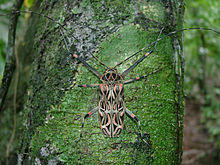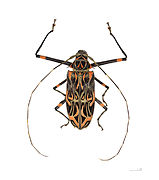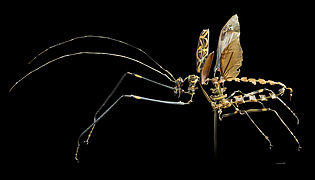| Harlequin beetle | |
|---|---|
 | |
| The beetle in its habitat | |
.jpg) | |
| Scientific classification | |
| Kingdom: | Animalia |
| Phylum: | Arthropoda |
| Class: | Insecta |
| Order: | Coleoptera |
| Family: | Cerambycidae |
| Subfamily: | Lamiinae |
| Genus: | Acrocinus |
| Species: | A. longimanus |
| Binomial name | |
| Acrocinus longimanus (Linnaeus, 1758) | |
| Synonyms | |
| | |
The harlequin beetle (Acrocinus longimanus) is a tropical longhorned beetle native from southern Mexico to Uruguay.[1] The harlequin beetle feeds on sap and is given this name because of its elaborate pattern of black, red and greenish yellow markings on the wing covers of both sexes.[2] The species name longimanus is a Latin word that refers to the extremely long forelegs (manus) of the males, which are usually longer than the beetle’s entire body. As an adult, the species is very large, with a body that can measure nearly 76 mm (3 inches) in length.[3] It is also famous for carrying pseudoscorpions as a form of phoresy.
The harlequin beetle exhibits sexually dimorphic traits. Males have cephalic horns used in combat which are poorly developed or absent in females or enlarged mandibles. Dimorphism also occurs in the shape of the foreleg tibia which is nearly straight in females and exhibits varying degrees of curvature in males.[4]
The harlequin beetle contains three homologous peptides, Alo-1, Alo-2, and Alo-3. Alo-3 is the first peptide from insects that exhibits the knottin fold and shows a higher level of activity against the fungal species (Candida glabrata) than the Alo-1 and Alo-2 peptides. Currently, there is a lack of treatment for fatal hospital-acquired infections and other pathologies. The peptide Alo-3 found in Harlequin beetles could provide a treatment for these severe, life threatening infections.[5]
References
- ^ Henderson, Carrol L.; Janzen, Daniel H. (2010). Butterflies, Moths, and Other Invertebrates of Costa Rica: A Field Guide. University of Texas Press. p. 130. ISBN 978-0-292-71966-8. Retrieved 24 Jan 2011.
- ^ Evans, Arthur V.; Bellamy, Charles L. (2000). An inordinate fondness for beetles. University of California Press. p. 130. ISBN 978-0-520-22323-3. Retrieved 24 Jan 2011.
- ^ "Harlequin beetle." Encyclopædia Britannica Online.
- ^ Zeh, D., Zeh, J., & Tavakilian, G. (1992). Sexual Selection and Sexual Dimorphism in the Harlequin Beetle Acrocinus longimanus. Biotropica, 24(1), 86-96. doi:10.2307/2388476
- ^ https://pubs.acs.org/doi/pdf/10.1021/bi035400o "Solution structure of Alo-3: A new knottin-type antifungal peptide from the insect Acrocinus longimanus"
Further reading
- Zeh, David W.; Zeh, Jeanne A.; Bonilla, Melvin M. (2003). "Phylogeography of the giant harlequin beetle (Acrocinus longimanus)". Journal of Biogeography. 30 (5): 747–753. doi:10.1046/j.1365-2699.2003.00880.x. ISSN 0305-0270.
- Zeh, David W.; Zeh, Jeanne A.; Tavakilian, Gerard (1992). "Sexual Selection and Sexual Dimorphism in the Harlequin Beetle Acrocinus longimanus". Biotropica. 24 (1): 86–96. doi:10.2307/2388476. ISSN 0006-3606. JSTOR 2388476.

